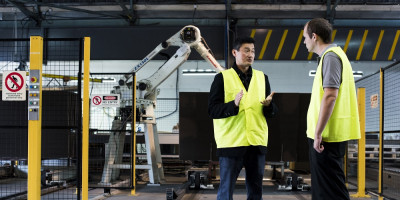Resources: Ārohia Trailblazer Grant
Resources: Ārohia Evidence Grant
Frequently asked questions : Ārohia Trailblazer Grant
If you require co-funding from an external or third-party source, you must secure it within 6 months of the contract start date. For the current round of funding (round 2), the anticipated contract start date will be September 1st, 2024.
Great ideas that are well formed but haven’t yet been launched to the open market.
The Ārohia Innovation Trailblazer Grant supports innovation that you haven’t already taken to market, i.e. it’s pre-launch and not yet generating sales.
If your innovation is already being sold at its intended full price and being delivered in its final form then we would consider it to be ‘in the market’ and therefore ineligible for this grant. Further, if your product is launched locally but you’re looking to take it international, this would be ineligible for the Ārohia Innovation Trailblazer Grant.
Pre-sales aimed at generating initial sales leads before the innovation is fully available in the market will not be considered as actual sales, provided they occur at the pre-launch phase. Also, we won’t assume your innovation is in the market, if you’re conducting a beta trial or early adopter test.
Innovations that are world-leading and groundbreaking
To help us determine the world-leading nature of your innovation, we will consider how novel it is, i.e. is it completely new, or a significant enhancement or scaling up of what currently exists:
-
- in the world, or
- within a particular sector/industry globally, or
- in Aotearoa New Zealand, or
- within a particular sector/industry in Aotearoa New Zealand
An innovation that’s novel in the world will clearly be world-leading, as it will be the first of its kind to ever exist.
An innovation at the other ‘levels’ described above could still be regarded as world-leading, if it meets or embodies what’s considered to be the recognised global standard in its field.
Remember that innovation in the context of the Ārohia Innovation Trailblazer Grant is not limited to new products - it can also be a new process, service or business model, or a combination of these.
This means, for example, you may be developing a product that already exists at the level at which you aim to introduce it, so the product itself is not novel. However, if you're employing an innovative new process to develop the product, then this may meet the eligibility for novelty.
For clarity, here’s how we define novelty at each of the levels outlined earlier:
Novel in the world: An innovation that’s adopted for the first time ever in the world.
Novel within a particular sector/industry globally: An innovation that’s adopted for the first time by a specific sector or industry in the world, but has already been adopted by at least one other sector/industry in the world.
Novel in Aotearoa New Zealand: An innovation that’s adopted for the first time in Aotearoa New Zealand, but has already been adopted in another country.
This may require some adaptation to suit our local conditions and customer needs.
Novel within a particular sector/industry in Aotearoa New Zealand: An innovation that’s adopted for the first time by a specific sector or industry in Aotearoa New Zealand, but has already been adopted by at least one other sector/industry in Aotearoa New Zealand.
What’s the difference between “completely new” and “a significant enhancement or scaling up?”
Completely new
An innovation that’s completely new is a product, service, process or business model (or combination of these) that’s never been launched in a market before.
It’s possible that potential competitors will be working on a similar solution, but if their solution has not yet been commercialised (offered for sale in a market) then your innovation can be considered “completely new.”
Significant enhancement
An innovation is a significant enhancement if it builds upon or improves an existing product, process, service or business model (or combination of these) to the point where it offers something well above and beyond what’s currently available.
This can include creating a unique combination of known elements that were previously only offered separately, to provide greater value than was previously possible.
Significant scaling up
An innovation is a significant scaling up if it takes something that already exists and applies it on a much larger scale, with the potential to achieve a level of impact not seen to date.
Completely new
An innovation that’s completely new is a product, service, process or business model (or combination of these) that’s never been launched in a market before.
It’s possible that potential competitors will be working on a similar solution, but if their solution has not yet been commercialised (offered for sale in a market) then your innovation can be considered “completely new.”
Significant enhancement
An innovation is a significant enhancement if it builds upon or improves an existing product, process, service or business model (or combination of these) to the point where it offers something well above and beyond what’s currently available.
This can include creating a unique combination of known elements that were previously only offered separately, to provide greater value than was previously possible.
Significant scaling up
An innovation is a significant scaling up if it takes something that already exists and applies it on a much larger scale, with the potential to achieve a level of impact not seen to date.
An innovation may be novel in multiple ways
When describing the novelty of your innovation, you should highlight all the ways in which it is novel, allowing for the fact that different aspects of your innovation may exhibit different degrees of novelty.
Novelty is not just about scientific or technological novelty
Novelty can stem from many factors, and is not limited to new scientific or technological R&D development.
Novelty can arise in any sector
The Ārohia Innovation Trailblazer Grant is open to businesses from all sectors. This recognises that novelty that can deliver benefits to the wider innovation ecosystem is not limited to any particular sector.
What’s an ineligible level of novelty?
An ineligible level of novelty in the context of the Ārohia Innovation Trailblazer Grant could include an innovation that is:
-
- new to a region/district/city within Aotearoa New Zealand but exists in another region/district/city in Aotearoa New Zealand
- new to the applicant's business but is already in use by another business in the same industry/sector, and does not represent a significant enhancement in design
- an incremental improvement, e.g. a minor quality, efficiency or performance improvement or upgrade to an existing product/service; or a simple modification to a core product formulation
- a brand repositioning of an existing product/service/process in an existing international market
- a localisation - i.e. an adaptation of an existing offering from one international market, for entry into a new international market
- reverse engineering or copying a competitor product, service or process that already exists
Ideas that are likely to be a genuine financial success, to the benefit of everyone involved.
When we assess the commercial potential of an innovation and whether the market has been validated, there are three factors we consider:
-
- market impact, i.e. will customers want it?
- commercial feasibility, i.e. can you make, deliver and support it?
- commercial viability, i.e. will it be financially successful?
We’ve chosen these factors because they’re widely regarded as the pivotal elements involved in determining commercial potential - and in a typical pitch to investors, you would be expected to speak to these three factors.
The questions we ask in the Ārohia Trailblazer Grant application therefore closely resemble those you would be expected to answer in a commercial capital raising scenario.
The following information lets you see in more detail what we mean by each of the three factors that together define commercial potential.
Market impact
Market Impact is about the impact your innovation will have in the marketplace, both in terms of:
-
- desirability/appeal to target customers (buyers and/or users)
- the size of the market created and anticipated market share over time.
When assessing market impact, we want to know about:
-
- the customer problem/unmet need that your innovation will address
- the solution that the innovation offers - e.g. how does it work, how does it solve the problem/unmet need and how does it benefit/add value for customers?
- how the innovation differs from what’s currently available to customers/users
- the size of the potential market, the market share that you hope to capture, and the growth you anticipate over time.
Commercial feasibility
Commercial feasibility is about critical factors involved in getting your innovation to market and operating it successfully.
There are three key areas we will focus on when assessing commercial feasibility:
-
- Team. A good team, comprising the right people, is one of the most important assets there is when it comes to taking an innovation to market.
- Go-to-market and channel plans. Regardless of the benefits your innovative idea is capable of delivering, it will remain an idea unless you can be sure of getting it into the hands of the customers who stand to gain from it.
- Technology roadmap. We want to be confident that any technological aspect of your solution is sufficiently robust to enable the successful commercialisation of your innovation.
Commercial viability
Commercial viability is about your innovation’s ability to financially succeed in the marketplace.
There are three key areas we will look at when assessing commercial viability:
-
- Business model and financials. Your innovation may have considerable appeal to customers, but unless it’s capable of making money, it’s unlikely to be the basis of a successful business or have any appeal to investors. A robust business model, showing how your innovation will generate a profit, is therefore very important.
- Sustainable growth roadmap. Launching a successful innovation is one thing, but you will also need to show how it will continue to retain its appeal and profitability beyond the short-term.
- Recent traction and partners. During the early stages of the innovation pathway, before you’ve actually launched something into the market, you don’t have any actual sales that can provide hard evidence of your innovation’s appeal. A strong indicator of an innovation’s potential, however, can come in the form of traction achieved pre-launch, such as significant successes or expressions of interest.
Market impact
Market Impact is about the impact your innovation will have in the marketplace, both in terms of:
-
- desirability/appeal to target customers (buyers and/or users)
- the size of the market created and anticipated market share over time.
When assessing market impact, we want to know about:
-
- the customer problem/unmet need that your innovation will address
- the solution that the innovation offers - e.g. how does it work, how does it solve the problem/unmet need and how does it benefit/add value for customers?
- how the innovation differs from what’s currently available to customers/users
- the size of the potential market, the market share that you hope to capture, and the growth you anticipate over time.
Commercial feasibility
Commercial feasibility is about critical factors involved in getting your innovation to market and operating it successfully.
There are three key areas we will focus on when assessing commercial feasibility:
-
- Team. A good team, comprising the right people, is one of the most important assets there is when it comes to taking an innovation to market.
- Go-to-market and channel plans. Regardless of the benefits your innovative idea is capable of delivering, it will remain an idea unless you can be sure of getting it into the hands of the customers who stand to gain from it.
- Technology roadmap. We want to be confident that any technological aspect of your solution is sufficiently robust to enable the successful commercialisation of your innovation.
Commercial viability
Commercial viability is about your innovation’s ability to financially succeed in the marketplace.
There are three key areas we will look at when assessing commercial viability:
-
- Business model and financials. Your innovation may have considerable appeal to customers, but unless it’s capable of making money, it’s unlikely to be the basis of a successful business or have any appeal to investors. A robust business model, showing how your innovation will generate a profit, is therefore very important.
- Sustainable growth roadmap. Launching a successful innovation is one thing, but you will also need to show how it will continue to retain its appeal and profitability beyond the short-term.
- Recent traction and partners. During the early stages of the innovation pathway, before you’ve actually launched something into the market, you don’t have any actual sales that can provide hard evidence of your innovation’s appeal. A strong indicator of an innovation’s potential, however, can come in the form of traction achieved pre-launch, such as significant successes or expressions of interest.
Creating new innovation opportunities for other businesses; opportunities that otherwise would not have existed.
The benefits we’re looking for are ways your innovation will help other innovators develop new ideas of their own, or seize opportunities that wouldn’t exist without your innovation having entered the market.
For the purposes of this grant, we’re not looking for wider benefits such as social, cultural, economic or environmental benefits, even though these may all result from your innovation.
Note: Innovation ecosystem benefits reflect what are referred to as “spillover benefits” in the Ārohia Innovation Trailblazer Grant Ministerial Direction.
What benefits are we looking for?
We’ve identified five key categories of benefit which we explain below. There’s also a wildcard category, so you’re welcome to tell us about a potential benefit that we haven’t identified.
There’s a high likelihood that innovation which is novel will inherently generate benefits for the innovation ecosystem.
When identifying the potential benefits of your innovation, take into account that benefits can:
-
- be created at any time during the development and implementation of your innovation - in the short term, they may result from activities carried out prior to market launch (with the support of grant funding); in the longer term they may result from or following the market launch of your innovation
- include learnings from successes and failures.
Innovation ecosystem benefits categories
What do we mean by this?
You introduce a new physical or digital capability in Aotearoa New Zealand that:
-
- others can leverage to accelerate the development of their own innovations
- enables others to collaborate to create a vibrant ecosystem around the new capability.
Physical capability could include new infrastructure such as a lab, production facility or equipment.
Digital capability could include a new cloud-based platform that enables other to:
-
- integrate their applications into the programme
- leverage Application Programming Interfaces (APIs) to benefit from the platform’s data, features and tools.
Could your innovation deliver this benefit?
Think about the ways your innovation could provide access to a new capability that:
-
- lifts a country up to a globally leading standard
- allows others to adopt cutting edge practices or use state-of-the-art equipment and facilities
- enables others to collaborate
- creates a vibrant ecosystem around the capability.
What do we mean by this?
The problem you’re trying to solve, or the innovative approach you’re taking, attracts others who see the potential in what you’re doing and want to be part of it.
The greater the pool of available expertise and talent, the greater the potential for cross-pollination of ideas that can generate new innovation opportunities.
Could your innovation deliver this benefit?
Think about the ways your innovation could attract the following, who will bring specialised knowledge and expertise to Aotearoa New Zealand:
-
- researchers
- academics
- investors
- suppliers
What do we mean by this?
Others can use the new knowledge and learnings that result from your activities and accomplishments, and apply this to solve new problems or create other new innovations.
This could be in the same sector/industry or beyond.
The new knowledge you create could be about a market, regulatory system, business practice or proof that a new pricing strategy or business model is possible.
A trailblazing innovation could also create original skillsets and specialist job roles.
Could your innovation deliver this benefit?
Think about the ways your innovation could generate the following:
-
- new knowledge that’s useful to others
- new skills, specialties or talent pools
- a need for skills transfer and new educational pathways to attain these skills
- open source access to any IP learnings you’re willing to share - note that you don’t need to share IP when applying for this grant, however, we acknowledge some businesses may choose to make some of their IP open-source, to accelerate growth of their market category
- new datasets that other innovators can access to solve new problems
- shared evidence or case studies of your learnings and accomplishments
- new benchmarks or standards that inspire other innovators to lift their game.
What do we mean by this?
Your innovation creates new opportunities and enables new collaborations between actors in a supply chain, value chain or the wider start-up and innovation ecosystem.
This can include creating demand for:
-
- new complementary products or services
- new components or ingredients
- new materials
- new configuration of activities and resources in a supply chain or value chain.
Could your innovation deliver this benefit?
Think about the ways your innovation could:
-
- benefit others in the supply chain or value chain, e.g. by reconfiguring these networks or getting suppliers to do things differently
- foster new collaborations in the startup and innovation ecosystem
- inspire the creation of new innovations that could complement your own.
What do we mean by this?
Your innovation, and the work around it, sets an example and enables innovation by innovators under-represented in the current ecosystem.
This could include:
-
- Regional - innovators living outside of the major cities
- Sector - Innovators working in sectors that are generally not known for their scientific and technical abilities
- Ethnicity - Innovators in under-represented ethnic groups
- Gender - Female innovators.
Could your innovation deliver this benefits?
Think about ways that your innovation could:
-
- enhance local innovation ecosystems in rural areas.
- bring cutting-edge innovations to industries that have historically been resistant to advancement or change.
- create new opportunities specifically for under-represented groups.
What do we mean by this?
This is a type of benefit to the innovation ecosystem that’s different to the five benefit categories shown above, and that you think your innovation could deliver.
We may not have identified all the types of ecosystem benefits that could exist, so this is your opportunity to share an innovation ecosystem benefit that we haven’t thought of.
Could your innovation deliver this benefit?
To identify if your innovation could deliver a wildcard benefit, think about how it could benefit the innovation ecosystem in a way that we haven’t identified.
What benefits are out of scope?
Any private benefit or benefit beyond the innovation ecosystem itself is outside the scope of the Ārohia Innovation Trailblazer Grant.
Private benefits received by a business developing the innovation
-
- Direct economic benefits to the business e.g. ROI, revenue, profit
- Job creation and retention
- Increased competitiveness
- Increased brand recognition and appeal/equity
Benefits generated outside a business developing the innovation
-
- Enhanced community and personal wellbeing
- Preservation and development of cultural identity
- Environment benefits e.g reduced carbon emissions
- Growth in national or local employment, incomes or taxation
Prompts to help you identify and explain relevant benefits
Remember, this grant is about supporting innovation that can benefit the innovation ecosystem.
Your focus should be on the categories of innovation ecosystem benefits shown on this page.
It may help if you use the following prompts to get into the right frame of mind to identify the benefits we’re looking for:
Our innovation will create opportunities for other innovators in Aotearoa New Zealand (current and future) by…
The ways in which our innovation will support suppliers to do things differently include…
Because of our innovation project, other innovators in Aotearoa New Zealand will be able to do the following things that they weren’t able to do before …























